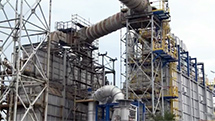European refining market
In Europe, the refining sector changed significantly in the wake of the 2008 global financial crisis. The 2009 drop in demand for petroleum products forced European refineries to reduce their output. This coincided with the construction of several conversion projects, which meant that the gap between low- and high-margin products also began to narrow. Furthermore, the United States, the largest buyer of gasoline from Europe, reduced its imports on the back of substantial increases in its own shale oil production. All of these developments have had a negative impact on the financial situation of European manufacturers, and consequently the European downstream sector is experiencing a major crisis.
Since 2009, several refineries, with a combined processing capacity of 3.7m bbl/d, have been closed down in Europe. However, this scaling back still seems insufficient, as many European refineries continue to generate low returns, with their processing capacities still relatively underutilised.
A number of burdens resulting from EU legislation have been imposed on European refineries, which renders them less competitive as compared to those located outside the EU. In effect, the dip in production observed is bigger than that in demand.
The shutting down of European refineries poses a risk to Europe’s energy security, rendering EU countries more dependent on imported refining products, which, in turn, may increase their susceptibility to supply disruptions and their dependence on import terminals and refining product storage facilities.
Refinery shutdowns in Europe in 2011-2013 *
| Refinery | Owner | Country | Capacity (’000 bbl/d) | Date |
|---|---|---|---|---|
| Harburg | Shell | Germany | 110 | 2013 |
| Gela | Eni | Italy | 105 | 2013 |
| Falconara | API | Italy | 83 | 2013 |
| Porto Marghera | Eni | Italy | 80 | 2013 |
| Coryton | Petroplus | United Kingdom | 220 | 2012 |
| Petit Couronne | Petroplus | France | 162 | 2012 |
| Lisichansk | Rosneft | Ukraine | 160 | 2012 |
| Arpechim | Petrom | Romania | 70 | 2012 |
| Paramo | Unipetrol | Czech Republic | 20 | 2012 |
| Rome | Total | Italy | 86 | 2012 |
| Cremona | Tamoil | Italy | 90 | 2011 |
* Source: www.platts.com, Insight, December 2013
The average refining capacity utilisation in Europe was 71% in October 2013, with daily output falling below 9m bbl, one of the lowest levels in recent years. This change was a result of the decrease in refining margins in H2 2013, despite a large number of overhaul shutdowns at West European refineries (especially in Belgium and Sweden). By the end of 2013, European margins had become so low that even the most efficient refineries were recording them in the negative.
The average refining capacity utilisation in the US was 88.4% in November 2013, with several refineries brought back online following completion of their overhaul shutdowns.
Erosion of the crack margin was not equally spread between all product groups. Gasoline crack proved the weakest, which was a consequence of poor macroeconomic data from the US (including depressed fuel consumption). The lowest gasoline crack margin of USD 88.84 per tonne was recorded on October 10th 2013, while the highest crack of USD 245.73 per tonne was seen on February 19th 2013; the crack change for the year was -8.4% or USD -12.9 per tonne.
2013 crack margins for other products:
- Diesel oil – low: USD 96.18/t (February 28th 2013), high: USD 141.86/t (January 14th 2013) – annual change: +26.9% or USD +29.3/t
- Jet fuel – low: USD 120.75/t (May 3rd 2013), high: USD 213.16/t (February 11th 2013) – annual change: +9.8% or USD +16.3/t
- Light fuel oil – low: USD 69.25/t (May 3rd 2013), high: USD 133.49/t (February 15th 2013) – annual change: +30.2% or USD +26.3/t
- Heavy fuel oil – low USD -293.11/t (September 6th 2013), high: USD -170.37/t (April 17th 2013) – annual change: +4.3% or USD +11.6/t.
Source: In-house analysis based on Thomson Reuters data.2013 crack margins (USD/t)
As its main feedstock, Grupa LOTOS uses Russian REBCO crude (Russian Export Blend Crude Oil). Compared with the global Brent benchmark, REBCO is a heavier crude, has greater density and a higher sulfur content, and yields more middle distillates (diesel oil, aviation fuel). On the other hand, REBCO processing produces more residual fractions for use in the production of cheap heavy fuel oil. The economic viability of the Gdańsk refinery’s processing work depends heavily on the Brent/REBCO differential. Given its slightly lower quality parameters, REBCO crude is usually marginally cheaper than Brent. However, the differential varies from time to time and is subject to seasonality. With a high negative differential, refineries which rely on REBCO crude record higher margins.
Source: In-house analysis based on Thomson Reuters data.Urals/Brent differential in 2010-2013
Industry analysts’ predictions for the future of the European refining sector are not optimistic, as fuel consumption is expected to decline even further. This downward trend creates additional pressure on refineries, forcing them to reduce their processing costs. In this context, improvements in the refinery’s efficiency by adjusting its configuration (depth of crude processing) and optimising its units become crucial.





















 E-mail
E-mail Facebook
Facebook Google+
Google+ Twitter
Twitter